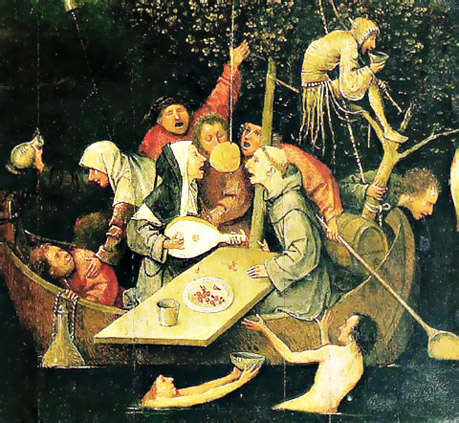The finale of our middle school Adventure Games Enrichment Camp tournament took us outside of the classroom and down to the school cafeteria, where the students piloted their treasure-laden sailing ships across the floor, unleashing barrages of marshmallow cannonballs at one another.
 |
| Bosch of course! |
Before jumping into the action, however, there were ample opportunities for kids to use their brains and flex their strategic muscles.
Throughout the prior week, each of our four-student teams had earned up to 6000 points through victories in the roughly sixty individual game sessions run by myself and my high school volunteers.
Between each event, the teams would huddle and decide among themselves where each team member should compete next, taking into account individual player skill, likely competition faced, number of points up for grabs in a match, and personal interest in a particular game.
In some cases the kids made some pretty cagey moves: the Red "Bhatvian" Team threw a match at one point in exchange for the Blue Team doing the same in a different event; two Yellow Team "Marklanders" each paid the entry fee in points to compete in Robo Rally, thinking to assure themselves a win by locking most the other competition out of the table.
Far from discouraging this kind of meta-game thinking, we carefully announced stakes, payouts, and displayed the up-to-date team rankings on our classroom's front board, tossing the students as much data as possible to help them make informed decisions. Of course sometimes fun won out over all other considerations and Dagger for Kids and Wiz-War both played to full tables even when the potential winnings were a long shot.
I knew that I wanted to use an extensive space outside of the classroom for my latest homebrew game Ghult: The Treasure Fleet, which would simulate the departure from the monster-haunted isle of Ghult and the progress made by the four teams as they sailed back homeward with holds full of plunder.
At first I intended to use the lengthy figure-eight of hallways around the school to represent sea lanes, but it turned out that high school summer-school students were taking end-of-course standardized tests that day and having a bunch of middle schoolers dashing through the hallways, shouting and throwing marshmallows probably wouldn't be well received.
 |
| The redoubtable Walvian crew |
Instead, and ultimately for the better, we ended up in the cafeteria, which was quite large and broken up by 18 separate columns.
I knew heading into the week that I planned to use the 12"x12" floor tiles lining the floor of every school I've ever visited to give us standard units of measurement for movement ... but of course the cafeteria had none ... it was a poured and coated in sections about 20' to a side.
Hmm ... how to make this work?
Okay, I'd have the kids use sticks to measure movement instead of tiles. A quick survey of the garage revealed a couple dowels, an inch-and-a-half cut of lumber, and a cardboard wrapping paper tube, no two the same length.
Then it hit me, the funky lengths weren't a problem, they were a feature.
"Okay, take the index card your team has been given and write down how many total points you want to spend on your team's choice of measuring sticks. The team with the highest bid gets the longest stick."
 |
| A helmsman puts the stick to work. |
After purchasing their movement increments, the teams were able to buy upgrades for their ships (extra cannon, additional hull points, more maneuverability) using their remaining gold point total from the week. Some teams spent liberally, figuring that a tricked out vessel would win them the game, while other teams shepherded their points carefully, taking a conservative approach toward trying to get the win.
Finally, the members of each team were given one of four separate positions:
- Captain: you have final say in group decisions, your vote breaks any ties, and you are in charge of deciding on the team's strategy
- First Mate: you are in charge of firing the "cannons"; any time a marshmallow touches a ship (even if by accident) it counts as a hit
. - Helmsman: you are in charge of using the stick and moving the ship; nobody else can turn or move the ship
- Lieutenant: you are in charge of signaling and communications with other vessels and referees
"Get to the Island of Paak, loot the ancient temple, and sail away with the treasure. The team who leaves the play area with the highest total in gold points wins both the game and the tournament!"
 |
| Cafeteria tables and trashcans provided some unforeseen terrain. Here a Plukish ship takes advantage of "a low fog bank". |
A grand time was had by all.


No comments:
Post a Comment